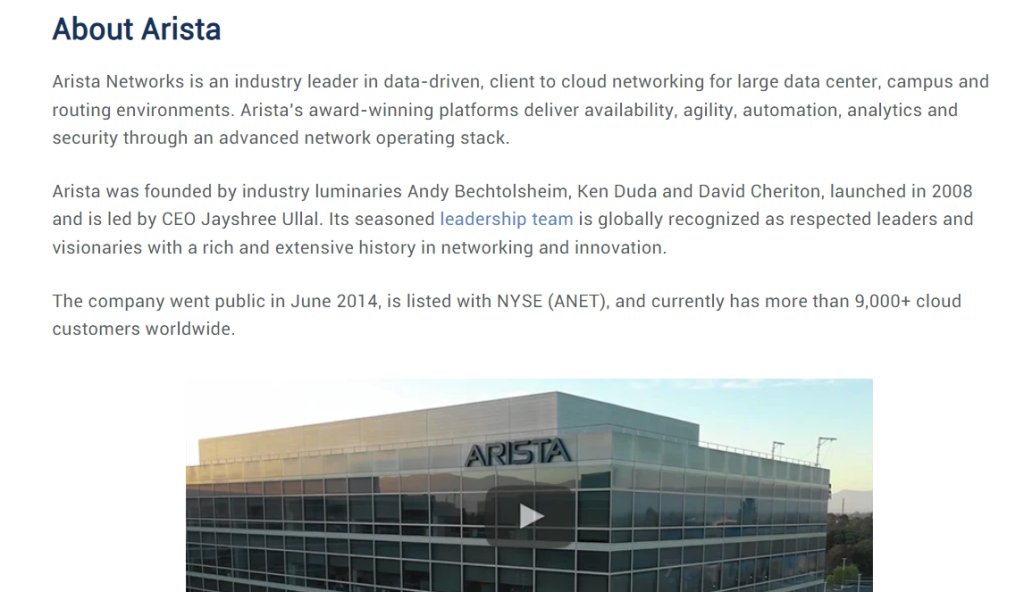Table of Contents
ToggleA Brief History of Arista
Arista Networks was founded in 2004 by Andy Bechtolsheim, David Cheriton, and Ken Duda, all of whom had extensive experience in the technology industry. Andy Bechtolsheim, a co-founder of Sun Microsystems, provided initial funding for the company. David Cheriton, a computer science professor at Stanford University and an early investor in Google, brought his expertise in networking and distributed systems. Ken Duda, who had worked with Bechtolsheim at Sun Microsystems, contributed his knowledge in network software development.
The company’s primary goal was to revolutionize the networking industry by focusing on high-performance computing environments, cloud computing, and big data. Arista Networks aimed to address the growing demand for scalable and reliable networking solutions in data centers.
In 2008, Arista Networks introduced its first product, the Arista 7000 series of data center switches, which quickly gained attention for their high-speed, low-latency capabilities. These switches were powered by Arista’s Extensible Operating System (EOS), a Linux-based network operating system designed for reliability, programmability, and scalability.
Over the years, Arista Networks continued to innovate and expand its product line, introducing switches tailored for various use cases in data centers, cloud computing, and high-frequency trading environments. The company gained significant market share in the networking industry, competing with established players like Cisco Systems and Juniper Networks.
Arista Networks went public in 2014, trading on the New York Stock Exchange under the ticker symbol “ANET.” Since then, the company has continued to grow its customer base and expand its global presence, maintaining its reputation for high-performance networking solutions and innovative technology.
Who Owns Arista?
Arista Networks, Inc. is a publicly traded company, so its ownership is dispersed among a large number of shareholders. The company’s top 10 shareholders are institutional investors such as BlackRock, Vanguard Group, T. Rowe Price Associates, State Street Corporation, and Fidelity Management & Research Company. These institutions hold significant stakes in the company and play a major role in its ownership structure. Additionally, some of the company’s co-founders and executives may also hold significant ownership stakes in Arista Networks, Inc. Overall, the ownership of the company is diverse and spread across a wide range of investors and stakeholders.
Arista Mission Statement

Arista Networks, Inc. is dedicated to providing innovative and high-performance network solutions to enable the next generation of cloud networking. With a focus on delivering scalable and reliable products, Arista Networks is committed to empowering businesses to build and manage their networks with simplicity and efficiency. Their mission is to revolutionize the way data centers are designed and operated, ultimately transforming the way organizations connect and collaborate in the digital world.
How does Arista Make Money?
Arista Networks, Inc. operates as a provider of cloud networking solutions and has a business model that primarily focuses on the sale of hardware, software, and services related to data center networking. The company generates revenue through the sale of its networking products, including switches, routers, and software subscriptions, to enterprise customers and cloud service providers. Arista Networks also offers professional services, training, and support to its customers, which contributes to its overall revenue stream. Additionally, the company earns revenue through ongoing maintenance and support contracts with its customers. Overall, Arista Networks generates its revenue through a combination of product sales and recurring service contracts.
Arista Business Model Canvas
The Business Model Canvas is a strategic management tool that provides a visual representation of a company’s business model. It breaks down key components such as customers, value propositions, channels, customer relationships, revenue streams, key resources, key activities, key partners, and cost structure in order to help organizations refine their business strategies and identify areas for improvement.
Customer Segments:
– Large Enterprises: Arista Networks targets large enterprises such as cloud service providers, financial institutions, and high-tech companies that require high-performance networking solutions.
– Data Center Operators: The company also focuses on data center operators who need efficient and reliable networking infrastructure.
Value Propositions:
– High-Performance Networking: Arista Networks offers high-performance, scalable, and reliable networking solutions for data centers and cloud computing environments.
– Open Networking: Arista’s open networking platforms provide flexibility, interoperability, and programmability to meet the evolving needs of customers.
– Innovative Technology: The company’s innovative networking technologies and software enable customers to achieve high-quality, efficient, and cost-effective networking solutions.
Channels:
– Direct Sales Force: Arista Networks uses a direct sales force to reach out to customers and sell its networking solutions.
– Channel Partners: The company also leverages channel partners, including resellers and system integrators, to expand its reach and access new customer segments.
Customer Relationships:
– Personal Selling: Arista Networks emphasizes personal selling to build strong relationships with its customers and provide customized networking solutions.
– Customer Support: The company offers 24/7 customer support to ensure high levels of customer satisfaction and ongoing maintenance of its networking products.
Revenue Streams:
– Product Sales: Arista Networks generates revenue through the sale of its networking hardware, software, and accessories.
– Software Subscriptions: The company also offers software subscriptions and maintenance services to generate recurring revenue from its customers.
Key Resources:
– Technology and Innovation: Arista Networks invests heavily in research and development to continually innovate and develop cutting-edge networking technologies.
– Skilled Workforce: The company relies on a highly skilled workforce to design, manufacture, and support its networking products.
Key Activities:
– Product Development: Arista Networks focuses on continuous product development to enhance its networking solutions and stay ahead of the competition.
– Sales and Marketing: The company carries out extensive sales and marketing activities to promote its products and expand its customer base.
Key Partners:
– OEM Partners: Arista Networks collaborates with original equipment manufacturers (OEMs) to integrate its networking solutions into hardware platforms.
– Technology Partners: The company also partners with technology providers to deliver complementary products and services to its customers.
Cost Structure:
– Research and Development: Arista Networks incurs significant costs in research and development to drive innovation and develop new networking solutions.
– Sales and Marketing: The company allocates resources to sales and marketing activities to promote and sell its networking solutions to customers.
Arista’s Competitors
Arista Networks, Inc. is a leading provider of cloud networking solutions for large data center and high-performance computing environments. The company’s competitors include:
1. Cisco Systems, Inc.
2. Juniper Networks, Inc.
3. Hewlett Packard Enterprise Company
4. Dell Technologies, Inc.
5. Extreme Networks, Inc.
Arista SWOT Analysis
Strengths:
1. Strong reputation as a leader in high-performance networking solutions.
2. Focus on innovation and continuous development of cutting-edge technology.
3. High customer satisfaction and retention rates.
4. Strong financial performance and consistent revenue growth.
Weaknesses:
1. Reliance on a limited number of key customers for a significant portion of revenue.
2. Vulnerability to market fluctuations and changes in customer demand.
3. Limited global presence compared to some competitors.
4. Dependence on third-party suppliers for key components.
Opportunities:
1. Growing demand for cloud-based networking solutions.
2. Expansion into new geographical markets and customer segments.
3. Increasing adoption of software-defined networking (SDN) and network virtualization technologies.
4. Opportunities for strategic partnerships and acquisitions to enhance product offerings.
Threats:
1. Intense competition in the networking industry from larger, more established players.
2. Rapid changes in technology and evolving industry standards.
3. Potential impact of economic downturns and global events on customer spending.
4. Regulatory challenges and compliance requirements in different markets.
Concluding Analysis
So, in wrapping up my analysis of Arista Networks, Inc.’s business model, I have to say I’m impressed. The company’s focus on cloud networking and the shift towards software-driven solutions is definitely paying off. With their commitment to innovation and their strong position in the market, I see a bright future for Arista Networks. As an analyst, I believe that the company’s strategic approach and adaptability will continue to serve them well in an ever-changing industry. Overall, I’m confident that Arista Networks, Inc. will remain a key player in the networking world and will continue to thrive in the years to come.
Additional Resources
To keep learning and advancing your career, we highly recommend these additional resources:
Business Model Canvas of The Top 1,000 Largest Companies by Market Cap in 2024
A List of 1000 Venture Capital Firms & Investors with LinkedIn Profiles
Peter Thiel and the 16 Unicorns: The Legacy of Thiel Fellowship












